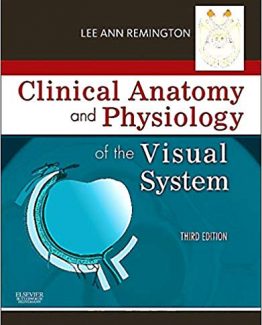Bailey & Scott’s Diagnostic Microbiology 15th Edition by Patricia M. Tille, ISBN-13: 978-0323681056
[PDF eBook eTextbook]
- Publisher: Elsevier; 15th edition (March 11, 2021)
- Language: English
- 1184 pages
- ISBN-10: 0323681050
- ISBN-13: 978-0323681056
Perfect your lab skills with the essential text for diagnostic microbiology! Bailey & Scott’s Diagnostic Microbiology, 15th Edition is known as the #1 bench reference for practicing microbiologists and as the preeminent text for students in clinical laboratory science programs. With hundreds of full-color illustrations and step-by-step methods for procedures, this text provides a solid, basic understanding of diagnostic microbiology and also covers more advanced techniques such as matrix-assisted laser desorption time-of-flight mass spectrometry. Written by noted CLS educator Dr. Patricia Tille, Diagnostic Microbiology has everything you need to get accurate lab test results in class and in clinical practice.
Table of Contents:
Cover image
Title page
Disclaimer
Table of Contents
Copyright
Dedication
Reviewers
Contributors
Preface
Part I. Basic Medical Microbiology
1. Microbial Taxonomy
Classification
Nomenclature
Identification
2. Bacterial Genetics, Metabolism, and Structure
Bacterial Genetics
Bacterial Metabolism
Structure and Function of the Bacterial Cell
3. Host-Microorganism Interactions
The Encounter Between Host and Microorganism
Microorganism Colonization of Host Surfaces
Microorganism Entry, Invasion, and Dissemination
Outcome and Prevention of Infectious Diseases
General Principles in Clinical Microbiology
Section 1. Safety and Specimen Management
4. Laboratory Safety
Sterilization, Disinfection, and Decontamination
Chemical Safety
Fire Safety
Electrical Safety
Handling of Compressed Gases
Biosafety
Exposure Control Plan
Employee Education and Orientation
Disposal of Hazardous Waste
Standard Precautions
Laboratory Design and Engineering Controls
Biological Safety Levels
Mailing Biohazardous Materials
5. Specimen Management
General Concepts for Specimen Collection and Handling
Specimen Preservation
Specimen Work-Up
Expediting Results Reporting: Computerization
Section 2. Approaches to Diagnosis of Infectious Diseases
6. Role of Microscopy
Bright-Field (Light) Microscopy
Phase-Contrast Microscopy
Fluorescent Microscopy
Dark-Field Microscopy
Digital Automated Microscopy
Digital Holographic Microscopy
7. Overview of Conventional Cultivation and Systems for Identification
Organism Identification
Principles of Bacterial Cultivation
Bacterial Cultivation
Principles of Identification
Principles of Phenotypic Identification Schemes
Commercial Identification Systems and Automation
8. Nucleic Acid–Based Analytic Methods for Microbial Identification and Characterization
Overview of Nucleic Acid–Based Methods
Postamplification End-Point Analysis
9. Overview of Immunochemical Methods Used for Organism Detection
Features of the Immune Response
Features of the Humoral Immune Response Useful in Diagnostic Testing
Interpretation of Serologic Tests
Production of Antibodies for Use in Laboratory Testing
Immunoglobulin M Clinical Significance
Separating Immunoglobulin M from Immunoglobulin G for Serologic Testing
Principles of Immunochemical Methods Used for Organism Detection
Summary
Section 3. Evaluation of Antimicrobial Activity
10. Principles of Antimicrobial Action and Resistance
Antimicrobial Action
Mechanisms of Antibiotic Resistance
11. Laboratory Methods and Strategies for Antimicrobial Susceptibility Testing
Goal and Limitations
Testing Methods
Laboratory Strategies for Antimicrobial Susceptibility Testing
Accuracy
Communication
Bacteriology
Section 1. Principles of Identification
12. Overview of Bacterial Identification Methods and Strategies
Rationale for Approaching Organism Identification
Future Trends of Organism Identification
Section 2. Catalase-Positive, Gram-Positive Cocci
13. Staphylococcus, Micrococcus, and Similar Organisms
General Characteristics
Epidemiology
Pathogenesis and Spectrum of Disease
Laboratory Diagnosis
Antimicrobial Susceptibility Testing and Therapy
Prevention
Section 3. Catalase-Negative, Gram-Positive Cocci
14. Streptococcus, Enterococcus, and Similar Organisms
General Characteristics
Epidemiology
Pathogenesis and Spectrum of Disease
Laboratory Diagnosis
Antimicrobial Susceptibility Testing and Therapy
Prevention
Section 4. Non-Branching, Catalase-Positive, Gram-Positive Bacilli
15. Bacillus and Similar Organisms
General Characteristics
Laboratory Diagnosis
Antimicrobial Susceptibility Testing and Therapy
Prevention
16. Listeria, Corynebacterium, and Similar Organisms
General Characteristics
Epidemiology
Pathogenesis and Spectrum of Disease
Laboratory Diagnosis
Antimicrobial Susceptibility Testing and Therapy
Prevention
Treatment
Section 5. Non-Branching, Catalase-Negative, Gram-Positive Bacilli
17. Erysipelothrix, Lactobacillus, and Similar Organisms
General Characteristics
Epidemiology
Pathogenesis and Spectrum of Disease
Laboratory Diagnosis
Prevention
Section 6. Branching or Partially Acid-Fast, Gram-Positive Bacilli
18. Nocardia, Streptomyces, Rhodococcus, and Similar Organisms
General Characteristics
Epidemiology and Pathogenesis
Laboratory Diagnosis
Antimicrobial Susceptibility Testing and Therapy
Prevention
Section 7. Gram-Negative Bacilli and Coccobacilli (MacConkey-Positive, Oxidase-Negative)
19. Enterobacterales
General Characteristics
Epidemiology
Pathogenesis and Spectrum of Diseases
Specific Organisms
Laboratory Diagnosis
Prevention
20. Acinetobacter, Stenotrophomonas, and Other Organisms
General Characteristics
Epidemiology
Pathogenesis and Spectrum of Disease
Laboratory Diagnosis
Cultivation
Antimicrobial Resistance and Antimicrobial Susceptibility Testing
Antimicrobial Therapy
Prevention
Section 8. Gram-Negative Bacilli and Coccobacilli (MacConkey-Positive, Oxidase-Positive)
21. Pseudomonas, Burkholderia, and Similar Organisms
General Characteristics
Epidemiology
Pathogenesis and Spectrum of Disease
Laboratory Diagnosis
Antimicrobial Susceptibility Testing and Therapy
Prevention
22. Achromobacter, Rhizobium, Ochrobactrum, and Similar Organisms
General Characteristics
Epidemiology
Pathogenesis and Spectrum of Disease
Laboratory Diagnosis
Antimicrobial Susceptibility Testing and Therapy
Prevention
23. Chryseobacterium, Sphingobacterium, and Similar Organisms
General Characteristics
Epidemiology
Pathogenesis and Spectrum of Disease
Laboratory Diagnosis
Antimicrobial Susceptibility Testing and Therapy
Prevention
24. Alcaligenes, Comamonas, and Similar Organisms
General Characteristics
Epidemiology
Pathogenesis and Spectrum of Disease
Laboratory Diagnosis
Antimicrobial Susceptibility Testing and Therapy
Prevention
25. Vibrio, Aeromonas, Plesiomonas shigelloides, and Chromobacterium violaceum
General Characteristics
Epidemiology
Pathogenesis and Spectrum of Disease
Laboratory Diagnosis
Antimicrobial Susceptibility Testing and Therapy
Prevention
Section 9. Gram-Negative Bacilli and Coccobacilli (MacConkey-Negative, Oxidase-Positive)
26. Sphingomonas and Similar Organisms
General Considerations
Epidemiology, Spectrum of Disease, and Antimicrobial Therapy
Laboratory Diagnosis
Prevention
27. Moraxella and Neisseria spp.
General Characteristics
Epidemiology, Spectrum of Disease, and Antimicrobial Therapy
Laboratory Diagnosis
Antimicrobial Susceptibility
Prevention
28. Eikenella corrodens and Similar Organisms
General Characteristics
Epidemiology, Spectrum of Disease, and Antimicrobial Therapy
Laboratory Diagnosis
Serodiagnosis
Prevention
29. Pasteurella and Similar Organisms
General Characteristics and Taxonomy
Epidemiology, Spectrum of Disease, and Antimicrobial Therapy
Laboratory Diagnosis
Serodiagnosis
Serodiagnosis
Prevention
30. Actinobacillus, Kingella, Cardiobacterium, Capnocytophaga, and Similar Organisms
General Characteristics
Epidemiology, Pathogenesis, and Spectrum of Disease and Antimicrobial Therapy
Laboratory Diagnosis
Nucleic Acid Detection
Serodiagnosis
Prevention
Section 10. Gram-Negative Bacilli and Coccobacilli (MacConkey-Negative, Oxidase-Variable)
31. Haemophilus
General Characteristics
Epidemiology
Pathogenesis and Spectrum of Disease
Laboratory Diagnosis
Antimicrobial Susceptibility Testing and Therapy
Prevention
Section 11. Gram-Negative Bacilli That Are Optimally Recovered on Special Media
32. Bartonella
Bartonella
Direct Detection Methods
33. Campylobacter, Arcobacter, and Helicobacter
Campylobacter and Arcobacter
Helicobacter spp
34. Legionella
General Characteristics
Pathogenesis and Spectrum of Disease
Laboratory Diagnosis
Antimicrobial Susceptibility Testing and Therapy
Prevention
35. Brucella
General Characteristics
Epidemiology and Pathogenesis
Spectrum of Disease
Laboratory Diagnosis
Antimicrobial Susceptibility Testing and Therapy
Prevention
36. Bordetella pertussis, Bordetella parapertussis, and Related Species
General Characteristics
Spectrum of Disease
Laboratory Diagnosis
Antimicrobial Susceptibility Testing and Therapy
Prevention
37. Francisella
General Characteristics
Epidemiology and Pathogenesis
Spectrum of Disease
Laboratory Diagnosis
Antimicrobial Susceptibility Testing and Therapy
Prevention
38. Streptobacillus spp. and Spirillum minus
Streptobacillus spp
Spirillum minus
Section 12. Gram-Negative Cocci
39. Neisseria and Moraxella catarrhalis
General Characteristics
Epidemiology
Pathogenesis and Spectrum of Disease
Laboratory Diagnosis
Antimicrobial Susceptibility Testing and Therapy
Prevention
Section 13. Anaerobic Bacteriology
40. Overview and General Laboratory Considerations
General Characteristics
Specimen Collection and Transport
Macroscopic Examination of Specimens
Direct Detection Methods
Specimen Processing
Anaerobic Media
Approach to Identification
Antimicrobial Susceptibility Testing and Therapy
41. Overview of Anaerobic Organisms
Epidemiology
Pathogenesis and Spectrum of Disease
Nucleic Acid Detection and MALDI-TOF MS (Gram-Positive)
Nucleic Acid Detection and MALDI-TOF MS (Gram-Negative)
Nucleic Acid Detection and MALDI-TOF MS
Prevention
Section 14. Mycobacteria and Other Bacteria With Unusual Growth Requirements
42. Mycobacteria
Mycobacterium tuberculosis Complex
Nontuberculous Mycobacteria
Laboratory Diagnosis of Mycobacterial Infections
Antimicrobial Susceptibility Testing and Therapy
Prevention
43. Obligate Intracellular and Nonculturable Bacterial Agents
Chlamydia
Rickettsia, Orientia, Anaplasma, and Ehrlichia
Coxiella
Tropheryma whipplei
Klebsiella granulomatis
44. Cell Wall–Deficient Bacteria: Mycoplasma and Ureaplasma
General Characteristics
Epidemiology and Pathogenesis
Spectrum of Disease
Laboratory Diagnosis
Cultivation
Susceptibility Testing and Therapy
Prevention
45. The Spirochetes
Treponema
Borrelia
Brachyspira
Leptospira
Prevention
Part IV. Parasitology
46. Overview of the Methods and Strategies in Parasitology
Epidemiology
Pathogenesis and Spectrum of Disease
Laboratory Diagnosis
Approach to Identification
Prevention
Ectoparasites
47. Intestinal Protozoa
Amoebae
Flagellates
Ciliates
Sporozoa (Apicomplexa)
Microsporidia
48. Blood and Tissue Protozoa
Plasmodium spp
Babesia spp
Trypanosoma spp
Leishmania spp
49. Protozoa From Other Body Sites
Free-Living Amoebae
Naegleria fowleri
Acanthamoeba spp
Acanthamoeba Keratitis
Balamuthia mandrillaris
Trichomonas vaginalis
Toxoplasma gondii
50. Intestinal Nematodes
Ascaris lumbricoides
Enterobius vermicularis
Strongyloides stercoralis
Trichostrongylus spp
Trichuris trichiura
Capillaria philippinensis
Hookworms
Ancylostoma duodenale
Necator americanus
Ancylostoma ceylonicum, Ancylostoma braziliense, and Ancylostoma caninum
Results and Reporting
51. Tissue Nematodes
Trichinella spp
Toxocara canis (Visceral Larva Migrans) and Toxocara cati (Ocular Larva Migrans)
Baylisascaris procyonis (Neural Larva Migrans)
Ancylostoma braziliense and Ancylostoma caninum (Cutaneous Larva Migrans)
Dracunculus medinensis
Parastrongylus cantonensis (Cerebral Angiostrongyliasis)
Parastrongylus costaricensis (Abdominal Angiostrongyliasis)
Gnathostoma spinigerum
Capillaria hepatica
Dirofilaria immitis and Other Species
52. Blood and Tissue Filarial Nematodes
Wuchereria bancrofti
Brugia malayi and Brugia timori
Loa loa
Onchocerca volvulus
Mansonella spp. (M. ozzardi, M. streptocerca, M. perstans)
Dirofilaria spp. (D. immitis, D. repens, D. tenuis)
53. Intestinal Cestodes
Diphyllobothrium latum
Dipylidium caninum
Hymenolepis nana
Hymenolepis diminuta
Taenia solium
Taenia saginata
Taenia asiatica
Taenia crassiceps
54. Tissue Cestodes
Taenia solium
Echinococcus granulosus Complex
Echinococcus multilocularis
Echinococcus oligarthrus and Echinococcus vogeli
Taenia multiceps and Other Species
Taenia serialis
Spirometra mansonoides
55. Intestinal Trematodes
Echinostoma spp
Fasciolopsis buski General Characteristics
Gastrodiscoides hominis
Heterophyes: Metagonimus yokogawai, Centrocestus spp., Haplorchis spp., Stellantchamus spp., and Pygidiopsis spp. General Characteristics
56. Liver and Lung Trematodes
The Liver Flukes
The Lung Flukes
57. Blood Trematodes
General Characteristics
Epidemiology
Pathology and Spectrum of Disease
Laboratory Diagnosis
Therapy
Prevention
Part V. Mycology
58. Overview of Fungal Identification Methods and Strategies
Epidemiology
General Features of the Fungi
Taxonomy of the Fungi
Clinical Classification of the Fungi
Pathogenesis and Spectrum of Disease
Laboratory Diagnosis
General Considerations for the Identification of Yeasts
General Considerations for the Identification of Molds
General Morphologic Features of the Molds
Clinical Relevance for Fungal Identification
Laboratory Safety
Prevention
59. Hyaline Molds, Mucorales, Basidiobolales, Entomophthorales, Dermatophytes, and Opportunistic and Systemic Mycoses
The Mucorales
The Entomophthorales and Basidiobolales
The Dermatophytes
The Opportunistic Mycoses
Systemic Mycoses
60. Dematiaceous (Melanized) Molds
General Characteristics
Epidemiology and Pathogenesis Superficial Infections
Pathogenesis and Spectrum of Disease
Laboratory Diagnosis
61. Atypical and Parafungal Agents
Pneumocystis
Epidemiology
Pathogenesis and Spectrum of Disease
Laboratory Diagnosis
Rare Atypical and Parafungal Agents
62. The Yeasts and Yeastlike Organisms
General Characteristics
Epidemiology
Pathogenesis and Spectrum of Disease
Laboratory Diagnosis
Commercial Yeast Identification Systems
63. Antifungal Susceptibility Testing, Therapy, and Prevention
Antifungal Susceptibility Testing
Antifungal Therapy and Prevention
Part VI. Virology
64. Overview of the Methods and Strategies in Virology
General Characteristics
Epidemiology
Pathogenesis and Spectrum of Disease
Prevention and Therapy
Viruses That Cause Human Diseases
Laboratory Diagnosis
65. Viruses in Human Disease
Viruses in Human Disease
Adenoviridae
Arenaviridae
Astroviridae
Caliciviridae
Coronaviridae
Filoviridae
Flaviviridae
Hantaviridae
Hepadnaviridae
Hepeviridae
Herpesviridae
Herpesviruses
Varicella-Zoster Virus
Epstein-Barr Virus
Cytomegalovirus
Orthomyxoviridae
Papillomaviruses
Paramyxoviridae
Measles Virus
Parvoviridae
Picornaviridae
Enteroviruses, Parechoviruses, and Polioviruses
Rhinovirus
Hepatitis A Virus
Pneumoviridae
Polyomaviridae
Poxviridae
Reoviridae
Retroviridae
Rhabdoviridae
Togaviridae
Prions in Human Disease
66. Antiviral Therapy, Susceptibility Testing, and Prevention
Antiviral Therapy
Antiviral Resistance
Methods of Antiviral Susceptibility Testing
Prevention of Other Viral Infections
Part VII. Diagnosis by Organ System
67. Bloodstream Infections
General Considerations
Detection of Bacteremia
Special Considerations for Other Relevant Organisms Isolated From Blood
68. Infections of the Lower Respiratory Tract
General Considerations
Diseases of the Lower Respiratory Tract
Laboratory Diagnosis of Lower Respiratory Tract Infections
69. Upper Respiratory Tract Infections and Other Infections of the Oral Cavity and Neck
General Considerations
Diseases of the Upper Respiratory Tract, Oral Cavity, and Neck
Diagnosis of Upper Respiratory Tract Infections
Diagnosis of Infections in the Oral Cavity and Neck
70. Meningitis and Other Infections of the Central Nervous System
General Considerations
Shunt Infections
Laboratory Diagnosis of Central Nervous System Infections
71. Infections of the Eyes, Ears, and Sinuses
Eyes
Ears
Sinuses
72. Infections of the Urinary Tract
General Considerations
Infections of the Urinary Tract
Laboratory Diagnosis of Urinary Tract Infections
73. Genital Tract Infections
General Considerations
Genital Tract Infections
Laboratory Diagnosis of Genital Tract Infections
74. Gastrointestinal Tract Infections
Anatomy
Resident Gastrointestinal Microbiome
Gastroenteritis
Other Infections of the Gastrointestinal Tract
Laboratory Diagnosis of Gastrointestinal Tract Infections
75. Skin, Soft Tissue, and Wound Infections
General Considerations
Skin and Soft Tissue Infections
Laboratory Diagnostic Procedures
76. Normally Sterile Body Fluids, Bone and Bone Marrow, and Solid Tissues
Specimens From Sterile Body Sites
Laboratory Diagnostic Procedures
Part VIII. Clinical Laboratory Management
77. Quality in the Clinical Microbiology Laboratory
Quality Program
Specimen Collection and Transport
Standard Operating Procedure Manual
Personnel
Reference Laboratories
Patient Reports
Proficiency Testing
Performance Checks
Antimicrobial Susceptibility Tests
Maintenance of Quality Control Records
Maintenance of Reference Quality Control Stocks
Quality Assurance Program
Types of Quality Assurance Audits
Conducting a Quality Assurance Audit
Continuous Daily Monitoring
78. Infection Control
Incidence of Health Care–Associated Infections
Types of Health Care–Associated Infections
Emergence of Antibiotic-Resistant Microorganisms
Hospital Infection Control Programs
Role of the Microbiology Laboratory
Characterizing Strains Involved in an Outbreak
Preventing Health Care–Associated Infections
Surveillance Methods
79. Sentinel Laboratory Response to Bioterrorism
General Considerations
Government Laws and Regulations
Laboratory Response Network
Index
What makes us different?
• Instant Download
• Always Competitive Pricing
• 100% Privacy
• FREE Sample Available
• 24-7 LIVE Customer Support





